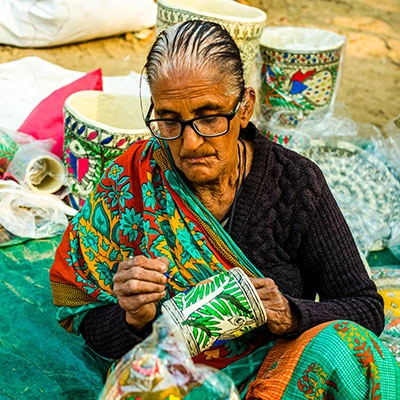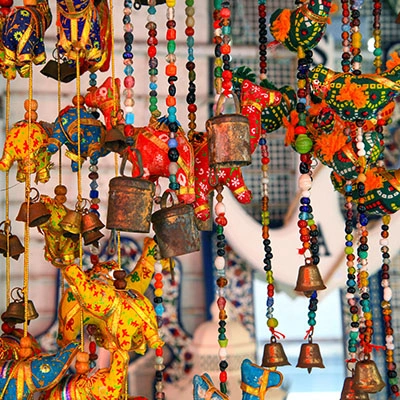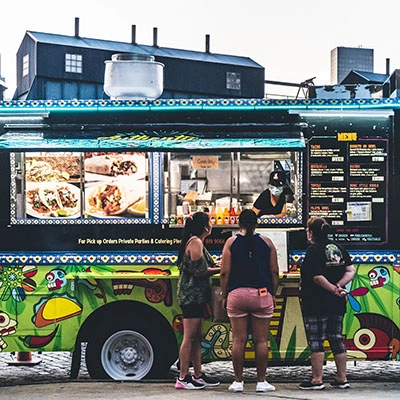Of all the wonderful things about international travel, one of our favorites is getting to experience cultures that differ dramatically from our own. From food to language, holiday customs to everyday activities, immersing yourself and learning about someone else’s traditions can be an eye-opening experience.
If you’re from the United States and can’t travel abroad right now — maybe your passport application has been delayed or you’re still saving money for your next big trip — you're in luck. There are plenty of destinations within our own borders that can still give you that faraway feeling.
We’ve all heard of Chicago’s Chinatown and the Italian North End in Boston. Those are excellent places to explore (and if you want some delicious Italian pastry, I can’t recommend Bova's Bakery enough). When you’re ready to branch out to some lesser-known sites, check out these American cities with a taste of the international.
A Note on Responsible Cultural Travel
The sites and cities you’re reading about are real people’s homes. You’ll be stepping into real people’s cultures. Visiting them should be done with the goal of learning about and appreciating them. Culture is not a spectacle. The people who live in these cities are not there for your amusement or to put on a show for you. Please treat them and their homes with respect.
1. Know the difference between cultural appropriation and cultural appreciation.
A key difference between cultural appropriation and cultural appreciation is whether you understand the significance of the object or symbol in question.
We often see this come into play when buying souvenirs on our travels. For example, you buy a piece of jewelry or artwork. If you wear or display it only because it looks pretty, that would typically be considered cultural appropriation. However, if you take the time to understand the meaning behind the object and what it represents, you’re on your way to cultural appreciation.
Sharing parts of another’s culture — whether it’s a souvenir, a photo, food, music or artwork — should be done with the intent to build awareness and increase understanding, not to serve your own personal interests.
2. Support local businesses.
Spending your tourism dollars with local businesses is a good way to support culture and can help you to avoid cultural appropriation. By supporting local businesses, you’re more likely to tap into authentic experiences and gain a truer understanding of the culture rather than a filtered version through an outside group.
Take the time to interact with the owner or vendor. Ask them about the item you’re buying or service you’re hiring. Open-minded, honest conversation is a great way to be a responsible traveler.
3. Respect language.
Even though you’re in the United States, many of these communities preserve the language of their native culture.
Just as if you were traveling abroad, you can show respect for your hosts by learning at least some basic words and phrases in that language. Do not disparage others for choosing to speak in another tongue.
4. Don’t yuck their yum.
Food is an integral part of many cultures and a delicious way for others to explore that culture. Be bold and sample the cuisine at these destinations, even if you aren’t familiar with it.
It’s okay if you decide you don’t like a dish, but be respectful about if and how you express your opinion. Your host may be very proud of their cuisine, or their food may be deeply rooted in tradition. It is not your place to say if their deliciousness is disgusting.
Check out these videos from TikTok creators @soojia1 (warning: adult language) and @mac.larena for how they approach others’ food with respect.
5. Reflect on your experience.
If you want a more immersive experience with travel, it pays to be mindful about what you’re experiencing.
- Did you catch yourself making comparisons with your own culture? If so, was the comparison rooted in judgment or appreciation?
- Did something make you uncomfortable? Examine why.
- Did your visit inspire you to learn more or dive deeper into a culture? Did it make you want to travel more?
Keeping a travel journal can be a helpful way to explore your experience more deeply, but it doesn’t have to be so formal. Talk it out with a trusted friend or simply sit quietly while you reflect on your own.
U.S. Destinations that Feel Like Another Country
You don’t always need to hop on an eight-hour transatlantic flight to feel like you’re somewhere new and exciting. Immerse yourself in one of these U.S. neighborhoods to break free from the ordinary and to travel for cheap without sacrificing adventure.
Los Angeles, California
It’s no secret that Los Angeles is one of the most ethnically diverse cities in the United States. The hardest part about going to L.A. will be deciding which part of the city you explore first.
Little Tokyo should be on your list as it’s one of only three official Japantowns in the country. Add the Japanese American Cultural & Community Center to your itinerary and enjoy the James Irvine Japanese Garden or catch a Kabuki performance while you’re there.
Get back out on the town and fuel up on authentic ramen or sushi. It’s hard to go wrong no matter which restaurant you pick. Visit in August for the Nisei Week Japanese Festival.
There’s so much more than Little Tokyo, though.
Few of us will make it to Iran, but a trip to Tehrangeles can give a glimpse. Larger numbers of Iranian refugees began arriving in Los Angeles in the 1970s. Some 40 years later, the City of Los Angeles renamed the area around Westwood Boulevard and Wilkins Avenue as Persian Square to recognize the vibrant businesses and culture these immigrants brought to the area.
Treat yourself to an ice cream, but don’t expect chocolate chip cookie dough to be on the menu. Look for flavors like rose and pistachio. If you’re lucky, you might even stumble across Faloodeh Persian ice cream, which is a rosewater sorbet with rice noodles and lime juice.
Hookah or waterpipe bars are common in this part of the city. While a symbol of friendship and trust, hookah does have the same detrimental health effects as smoking, so this might be a cultural activity you choose to observe rather than participate in.
Neither of these neighborhoods appeal to you? Then maybe you’d rather check out Historic Filipinotown, Little Armenia, or Little Ethiopia instead. You’ll find them all in Los Angeles.
San Jose, California
Little Saigon is home to innumerable Vietnamese restaurants, shops, history, and the largest Vietnamese community outside of Vietnam. Start your tour at the Viet Museum, also known as the Museum of the Boat People & the Republic of Vietnam. It took 30 years for this museum to go from idea to reality, and it’s dedicated to the history of Vietnamese refugees in the U.S.
Phở, pronounced “fuh,” is the national dish of Vietnam. If you can’t decide where to get a bowl of this noodle soup, grab a seat at Phở 79, which earned a James Beard Award in 2019. Phở isn’t the only soup popular in Vietnamese cuisine, though, so go ahead and get adventurous.
Travel to Little Saigon for Tết Nguyên Đán. Tết for short, or Vietnamese Lunar New Year in English, the festivities are in January or February, depending on the year. Regardless of the date, take in the Little Saigon Tết Parade, entertainment and games, food, and a firecracker show. The event allows families to honor their ancestors and pray for luck, prosperity, and health in the new year.
Louisville, Kentucky
When you think of U.S. cities with a strong Cuban influence, your mind probably goes farther south than Louisville. But depending on what statistics you look at, Louisville’s Cuban population is somewhere among the three largest in the country, rivaling Miami and Las Vegas.
While Louisville’s claim to fame is the Kentucky Derby, bourbon, and baseball bats, the changing demographics of the city mean you can also find the real Cuban deal with conga drums and ropa vieja. Havana Rumba is known as one of the first and tastiest restaurants in town, while La Bodeguita de Mima serves up a dish of nostalgia with 1950s-themed dining.
Find out where else the locals are eating, playing, and enjoying life by picking up a copy of El Kentubano, a magazine for Kentucky Cubans.
Pittsburgh, Pennsylvania
Having lived in Pittsburgh for a short time, I was somewhat surprised that only about 7% of yinzers identify as Polish, compared to more than 17% who claim German ancestry. (And, to diversify it even more, “yinzer,” the local name for a Pittsburgh resident, is said to come from Scottish-Irish immigrants.)
A major reason for the misconception that Pittsburgh is predominantly Polish: pierogi. If you go to Pittsburgh, pierogi, boiled dumplings stuffed with sweet or savory fillings, have to be on the menu.
Some of my favorites in the region were made by friends’ Polish grandmas. If you can’t find a sweet little old babcia, though, look for a market in the Polish Hill neighborhood selling pierogi and other treats. They might even be handmade by women from one of the local Polish churches.
And speaking of Polish churches, be sure to visit St. Stanislaus Kostka Church. This Catholic church is one of the oldest in the city and will make you feel like you’ve stepped through a portal into Europe.
New Ulm, Minnesota
This small town south of Minneapolis-St. Paul has a population of only about 14,000 people, but what New Ulm lacks in numbers, it makes up for in German-American spirit. It has nearly two centuries of history steeped in the stories of German immigrants.
Today, that can be experienced through sites like the Hermann Monument, a symbol of unity built in the midst of anti-immigrant sentiment prior to World War I; the German-Bohemian Immigrant Monument; the large Glockenspiel, a clocktower with more than 30 bells and a dozen figurines; and Schell’s Brewery, founded by a German immigrant and now open for tours that also include the founder’s home and, of course, beverage samples.
If you can brave Minnesota in the winter, time your visit to celebrate Fasching. This Mardi Gras-type festival meant to usher in the springtime is rooted in tradition from the Germanic Alps. Masked, colorful (and perhaps slightly terrifying, depending on your perspective) Narren open the festivities. Join them for traditional dancing, food, and more.
Alternatively, come back in the summer for Bavarian Blast if you like your festivals a little warmer.
Multicultural Cities in the U.S.
The United States is richly multicultural, but of course, this isn’t just because of immigration. Indigenous cultures, traditions preserved despite slavery, and other regional differences help to make us who we are as a nation.
“Indigenous” and "Native American” are sweeping terms that encompass many unique tribes. To pick a single destination where you can experience “Indigenous culture” would be both impossible and insensitive. Plus, not all communities welcome tourists.
If learning about an Indigenous culture interests you, do plenty of research. You might start your search in the American Southwest, particularly New Mexico. This is where you’ll find the adobe homes of the Taos Indians and Petroglyph National Monument outside Albuquerque.
Or you could turn to the Northwest. For starters, the Portland Art Museum in Oregon has a permanent Native American art collection in the Confederated Tribes of Grand Ronde Center for Native American Art. You’ll also find Bison Coffeehouse, the first Native-owned coffeehouse in Portland, which proudly supports Native roasters, artists, and causes in the community.
Alaskan Dream Cruises is the only Indigenous-owned cruise line in the U.S. These Alaskan cruises can dock where other ships can’t, partly because of their smaller size, but also because they are the only cruise line with permission to call at some ports, like Hobart Bay. Alaskan Dream Cruises takes sharing their ancestral home seriously, and you’re bound to experience Alaska in a way most other travelers miss.
Stretching along the U.S. East Coast from North Carolina down to northern Florida, the Gullah Geechee Cultural Heritage Corridor is known for its preservation of the Gullah Geechee culture. Many of these communities, created by freed slaves and their descendants, remained largely isolated and were able to retain much of the language, art, food, and religion from their Western African heritage.
If you’re asking where else you can go without a U.S. passport, put Puerto Rico, Guam, American Samoa, or the U.S. Virgin Islands on your list. American citizens can visit these U.S. territories the same as if they were crossing into another U.S. state.
Travel Insurance for U.S. Trips
Even if you live in the United States, you want to consider buying travel insurance for a trip in the U.S. With trip protection, you get coverage for prepaid, nonrefundable travel expenses if you have to cancel your trip or it’s delayed for a covered reason. You also get baggage protection, and with some plans, you can add medical coverage if it’s right for you.
Use our interactive guide at SevenCorners.com to find the right plan, or talk to a licensed agent.
Travel Like a Pro with The Wayfinder
Did you enjoy this blog? Get more articles like it before anyone else when you subscribe to our monthly newsletter, The Wayfinder.



